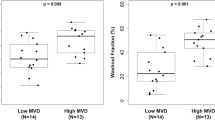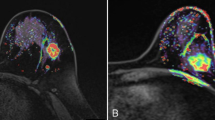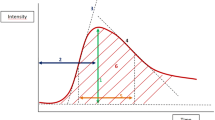Abstract
Background
We previously demonstrated that the density of tumor enhancement by intravenous digital subtraction angiography (IV-DSA) is correlated with the number of tumor microvessels and that the incidence of distant metastasis is high in patients with breast cancer who show a high maximum density of tumor enhancement (MAX) on IV-DSA. In the present study, we evaluated the prognostic value of MAX for node-negative breast cancer patients.
Patients and Methods
A total of 128 node-negative breast cancer patients underwent preoperative IV-DSA, and the region of interest (ROI) was set in the areas enhanced by IV-DSA of the breast. MAX was calculated by the time-density curve. Patients were divided into two subgroups: those with MAX ≥9 (n=35) and those with MAX <9 (n=93).
Results
Patients with recurrence had a significantly higher MAX value than those without recurrence (11.8±3.8 vs 7.1 ±3.0, p<0.01). The disease-free survival rate was significantly worse in patients with higher MAX values than in those with lower MAX values (p<0.001). Multivariate analysis showed that MAX was the strongest predictor of disease-free survival (p=0.026).
Conclusions
These results suggest that the maximum density obtained by IV-DSA is a strong, independent prognostic indicator for node-negative breast cancer patients.
Similar content being viewed by others
Abbreviations
- IV-DSA:
-
Intravenous digital subtraction angiography
- MAX:
-
Maximum density of tumor enhancement
References
Weidner N, Folkman J, Pozza F,et al: Tumor angiogenesis; A new significant and independent prognostic indicator in early-stage breast carcinoma.J Natl Cancer Inst 84:1875–1887, 1992.
Toi M, Kashitani J, Tominaga T: Tumor angiogenesis is an independent prognostic indicator in primary breast carcinoma.Int J Cancer 55:371–374, 1993.
Magennis DP: Angiogenesis; A new prognostic marker for breast cancer.Br J Biomed Sci 55:214–220, 1998.
Heimann R, Ferguson D, Gray S,et al: Assessment of intratumoral vascularization (angiogenesis) in breast cancer prognosis.Breast Cancer Res Treat 52:147–158, 1998.
Kato T, Kimura T, Ishii N,et al: The methodology of quantitation of microvessel density and prognostic value of neovascularization associated with long-term survival in Japanese patients with breast cancer.Breast Cancer Res Treat 53:19–31, 1999.
Obermair A, Kurz C, Czerwenka K,et al: Microvessel density and vessel invasion in lymph-node-negative breast cancer; Effect on recurrence-free survival.Int J Cancer 62:126–131, 1995.
Costello P, McCann A, Carney DN,et al: Prognostic significance of microvessel density in lymph node negative breast carcinoma.Hum Pathol 26:1181–1184, 1995.
Karaiossifidi H, Kouri E, Arvaniti H,et al: Tumor angiogenesis in node-negative breast cancer; Relationship with relapse free survival.Anticancer Res 16:4001–4002, 1996.
Heimann R, Ferguson D, Powers C,et al: Angiogenesis as a predictor of long-term survival for patients with node-negative breast cancer.J Natl Cancer Inst 88:1764–1769, 1996.
Eppenberger U, Kueng W, Schlaeppi JM,et al: Markers of tumor angiogenesis and proteolysis independently define high-and low-risk subsets of nodenegative breast cancer patients.J Clin Oncol 16:3129–3136, 1998.
Heimann R, Ferguson DJ, Hellman S: The relationship between nm23, angiogenesis, and the metastatic proclivity of node-negative breast cancer.Cancer Res 58:2766–2771, 1998.
Van Hoef ME, Knox WF, Dhesi SS,et al: Assessment of tumour vascularity as a prognostic factor in lymph node negative invasive breast cancer.Eur J Cancer 29:1141–1145, 1993.
Watanabe O, Haga S, Shimizu T,et al: Relationship between staining by digital subtraction angiography and vascularity in breast cancer; Analysis of the time-density curve and the results of staining for factor Vlll-related antigen/von Willebrand factor.Breast Cancer Res Treat 33:269–273, 1995.
Haga S, Watanabe O, Shimizu T,et al: Analysis of the tumor staining obtained by preoperative IV-DSA for breast cancer patients; Density and metastasis correlation.Breast Cancer Res Treat 43:129–135, 1997.
Haga S, Watanabe O, Shimizu T,et al: Relation between locoregional hyperthermic area detected by contact thermography and the maximum density of tumor stain obtained by IV-DSA in breast cancer patients.Breast Cancer 3:33–37, 1996.
Iacopetta B, Grieu F, Powell B,et al: Analysis of p53 gene mutation by polymerase chain reaction-single strand conformation polymorphism provides independent prognostic information in node-negative breast cancer.Clin Cancer Res 4:1597–1602, 1998.
Bryant J, Fisher B, Gunduz N.et al:: S-phase fraction combined with other patient and tumor characteristics for the prognosis of node-negative, estrogen-receptor-positive breast cancer.Breast Cancer Res Tret 51:239–253, 1998.
Linderholm B, Tavelin B, Grankvist K,et al: Vascular endothelial growth factor is of high prognostic value in node-negative breast carcinoma.J Clin Oncol 16:3121–3128, 1998.
Gasparini G, Toi M, Gion M,et al: Prognostic significance of vascular endothelial growth factor protein in node-negative breast carcinoma.J Natl Cancer Inst 89:139–147, 1997.
Author information
Authors and Affiliations
About this article
Cite this article
Watanabe, O., Haga, S., Shimizu, T. et al. Maximum density of tumor staining obtained by preoperative IV-DSA as a prognostic indicator for node-negative breast cancer. Breast Cancer 6, 365–369 (1999). https://doi.org/10.1007/BF02966455
Issue Date:
DOI: https://doi.org/10.1007/BF02966455




